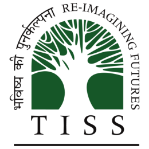TISS Patna Lecture Series on Migration, Lecture 14
Archived
Venue: SAP Building, History Department, Darbhanga House, Patna University, Ashok Rajpath, Patna
Title: Employee Benefits, Migration and Social Struggles: An Indian Coalfield, 1895-1970
Speaker: Dhiraj Kumar Nite
Labour migrancy has been regarded as a defining feature of the lifeworld of workers in Indian industrial centres. This paper complicates such an understanding by focusing on the transformation of oscillating migrants into regular, career mineworkers and their struggles over employee benefits, in an Indian coalfield around Jharia during 1895-1970.[1] On account of the development of employee benefits, the coal industry came to be considered, in the long run, as one of the best served in the private sector. The nationalisation of the coal industry in 1971-73 led to further broadening in scope and evening out its availability to workers. This study traces a correlation between patterns of migration and stabilisation of employees, on the one hand, and the development of employee benefits, on the other. It explains the role and approaches of oscillating migrant and settled workers to the question of employee benefits, with an objective to account for the existence and development of these benefits.
On the subject of labour migrancy and employee benefits, this study critically engages with three major perspectives. Some commentators argue that migrant workers acted as per their free and rational choices.[2] Workers remained oscillating migrants in Indian industrial centres because they maintained close links with their rural base, including family. Their real wages were higher in comparison with that of the artisans and workers employed in other urban and rural wage-works and their quality of life was on par.[3] My paper contends that the preceding thesis underestimates the coercion and constraint faced by workers and desire of workers for a better future in the urban context. It overlooks the inadequacy of employee benefits and social conflicts that ensued consequently. It maintains that industrial workers were able to assert themselves forcefully on the basis of rural connections and neighbourhood links, which proved a drag on the productivity and contributed to ‘economic backwardness’ and poverty.[4] It thus proposes that industrial workers were the victim of their own unreasonable choices and cultural patterns. My intervention brings to the fore another conception of the incentive structure, as articulated by the working-class public. It underlines a relationship between this incentive structure with migration and settlement and, in turn, the productiveness and wellbeing of mineworkers.
The second viewpoint argues that workers oscillated between the city and countryside because it was the only option for their survival under the circumstance of constraints and wants. Employers maintained a fluctuating level of employment, low wages and inadequate social security (especially housing). Labour migrancy suited the business requirement. The labour market was organised through non-economic forces: sub-infeudated social relations characterised the institution of recruitment, control and discipline of the workforce. Hence, circular migration was one of the strategies crucial for the functioning of the rural household and bolstering their positions in the village society. This ‘choice’- if it can be posited as such- gave way to crude necessity over time.[5] Indeed, desertion and the circulation of workers have been considered as an expression of the subterranean form of protest of semi-proletarians over insufficient social security in the destination economy.[6] This viewpoint is built on an assumption: had employers provided workers with salubrious conditions of living, migrant workers would have preferred to serve as a settled workforce. This conceptualises the preferences of semi-proletarianised and proletarianised workers in contrasting and essentialised terms. However, the actual gap between employee benefits on offer, and workers’ preferences, remains insufficiently examined. Our discussion below underscores the shifting contours of employees’ preferences and the struggle for fringe benefits. Unlike the cases in which the provision of employee benefits was noticeable by its absence,[7] our study demands attention to the involvement of workers, in what Polanyi terms the ‘countermovement’ against the self-regulating market, that is, the efforts at protecting working life by developing a modern reproduction arrangement.[8]
Workers did exercise a certain choice even in the constrained circumstances, suggest other commentators. Migrant workers maintained their interests in building up the homestead economy in their villages – this attachment to the rural homestead thwarted their fight for any employee benefits necessary for a settled life in the industrial centre.[9] At times, workers targeted intensification of work, demanded inflation allowances and opposed high-handedness. Notwithstanding this, workers were ‘labourers in-between’, living partially in both worlds of city and village.[10] Such a viewpoint, my study shows, inadequately reveals the social struggle over employee benefits and the approach adopted by oscillating workers towards this issue. Indeed, even the oscillating migrant had a certain preference for employee benefits as a necessary means of social security and satisfying a desire for advancing life and comfortable living in industrial centres.
My paper shows that the development of employee benefits positively influenced the patterns of migration and settlement of workers. Employers, guided by a new industrial sensibility, came up with specific [minimal] employee benefits with a view towards continuous production from a group of the settled and stable workforce. However, the approach adopted by workers to the question of social security and the pressure exerted by them shaped the expansion of their entitlement to employee benefits. The early mineworker held a view that children, extended family, land and livestock were the means of social security. This represented the social embeddedness of economic life of these workers, which was now exposed to destructive consequences of the commodification of labour. The landless and land-poor sections among them keenly appreciated the welfare measures, howsoever limited, offered to them by employers. They began to settle down around Jharia. Workers, generally, developed a notion of the civilised and humane form of life from the 1920s onwards. The self-respect campaign of the unprivileged caste groups, the movement of industrial democracy and national reconstruction, and the advocacy of International Labour Organization (ILO) for civilised and humane life for the working populace, brought about an impetus to the politics of new reproduction preferences.[11] Now, workers sought specific employee benefits, which they regarded necessary for improved living and advancing life. Their industrial struggle to realise enhanced reproduction supports formed the context in which a specific pattern of migration, settlement and stabilisation took place.
Notes:
[1] The Indian coalfield of Jharia is a shallow sickle shaped basin– about twenty-two miles long and fourteen miles broad– in the north of Damodar River. It is in the district of Manbhum (present-day Dhanbad, Eastern India) and is located 170 miles west of Calcutta. From 1895-1906, it developed as the largest coal-producing zone in the Indian subcontinent. As early as 1919-20, coal raisings in this coalfield touched 12 million tons a year and the overall number of mineworkers was about 100,000. The colliery population was 250,000. If we include the dependants of mineworkers of about 140,000, the colliery population numbered about 800,000 in 1960-61.
[2] Tirthankar Roy, Company of Kinsmen: Enterprise and Community in South Asian History 1700-1940, Delhi: OUP, 2010, pp. 153-189. Deepak Lal, The Hindu Equilibrium: India c. 1500-2000, New York: Oxford University Press, 2005, p. 237. Peter Gregory, The Myth of Market Failure. Employment and the Labour Market in Mexico, Washington: World Bank Research Publication, 1986.
[3] T. Roy and Anand Swamy, Law and the Economy in Colonial India, Chicago: Chicago University Press, pp. 104-22. Roy, Company of Kinsmen, pp. 176, 185. T Roy, ‘Labour Institutions, Japanese Competition, and the Crisis of Cotton Mills in Interwar Mumbai,’ Economic and Political Weekly (EPW), Vol. 43 (1), 2008, pp. 37-45, 41. T. Roy, ´Sardars, Jobbers, Kanganies: The Labour, Contractor and Indian Economic History,’ Modern Asian Studies (MAS), Vol. 42 (5), 2008, pp. 288, 292.
[4] BR Tomlinson, The Economy of Modern India, 1860-1970, Cambridge: Cambridge University Press, 1996, p. 115. Roy, ‘Labour Institutions’, pp. 41-44. Roy, ‘Sardars,’ p. 994. Susan Wolcott, ‘Industrial Labour in Late Colonial India’, in Latika Chaudhary, Bishnupriya Gupta, Trithankar Roy and Anand V Swamy (eds.), A New Economic History of Colonial India, New York: Routledge, 2016, pp. 195-217.
[5] Jan Breman, ‘The Study of Industrial Labour in Post-colonial India – The informal Sector: A concluding review,’ Contribution to Indian Sociology, Vol. 33 (1&2), 1999, pp. 407-32. J. Breman, Outcast Labour in Asia: Circulation and Informalisation at the Bottom of the Economy, Delhi: Oxford University Press, 2012, pp. 8, 11, 44, 171-80. Ranajit Dasgupta, ‘Migrants in Coal Mines: Peasants or Proletarians, 1850s-1947,’ Social Scientist, Vol. 13 (2), 1985, pp. 18-43. R. DasGupta, Labour and the Working Class in Eastern India, Calcutta: KP Bagchi & Co., 1994. Rajnaryan Chandavarkar, The Origins of Industrial Capitalism in India: Business Strategies and the Working Classes in Bombay, 1900-1940, Cambridge: Cambridge University Press, 1994/2002, pp. 124-165. Dilip Simeon, ‘Work and Resistance in the Jharia Coalfield, Contribution to Indian Sociology (CIS), Vol. 33 (1&2), 1999, pp. 43-72. D. Simeon, ‘Coal and Colonialism: Production Relations in an Indian Coalfield, 1895-1947,’ International Review of Social History, Vol. 41 (3, supplement issue), 1996, pp. 83-108.
[6] DasGupta, ‘Migrants’, p. 38. Rana Behal, One Hundred Years of Servitude: Political Economy of Tea Plantations in Colonial Assam, Delhi: Tulika Books, 2014, p. 269. Breman, ‘Industrial Labour’, p. 425.
[7] Chandavarkar, The Origins. Breman, Outcast Labour. C. Joshi, Lost Worlds: Indian Labour and Its Forgotten Histories, Delhi: Permanent Black, 2003.
[8] Karl Polanyi, The Great Transformation: the Political and Economic Origins of Our Time, US: Beacon Press, 1944/1957, pp. 141-48.
[9] Arjan De Haan, ´Unsettled Settlers: Migrant Workers and Industrial Capitalism in Calcutta,’ MAS, Vol. 31 (4), 1997, pp. 919-949. De Haan, ‘The Badli System in Industrial Labour Recruitment: Managers’ and Workers’ Strategies in Calcutta’s Jute Industry,’ CIS, Vol. 33 (1 & 2), 1999, pp. 271-301. Joshi, Lost Worlds, pp. 90-103. D. Simeon, The Politics of Labour under Late Colonialism: Workers, Union and the State in Chota Nagpur 1928-39, Delhi: Manohar, 1995, Chapter 1.
[10] Joshi, Lost Worlds, p. 99.
[11] My study advances this understanding that the factors involving labour and production relations, the dynamics of community identity and elite politics together shaped the articulation of interests among workers. The argument of Nair and Gooptu that both experiences of work relations and community identity influence the politics of working classes partly helps elucidate the case of India mineworkers. Janaki Nair, Miners and Millhands: Work, Culture and Politics in Princely Mysore. Delhi: Oxford University Press, 1998. Nandini Gooptu, The Politics of the Urban Poor in Early Twentieth-Century India, Cambridge: Cambridge University Press, 2003.
About the Speaker
Dr. Dhiraj Kumar Nite is Assistant Professor (Senior), Ambedkar University Delhi. In the past he has worked as Senior Research Associate, University of Johannesburg, South African Research Chair in Social Change. His research interests are history of labour relations and entrepreneurship; socio-economic history of the labour processes and the condition of wellbeing in the mining communities in India and South Africa; methodology of oral history; memory study, and historical anthropology.











